 |
Rails In Wolverhampton - The Early Years
by Bev Parker |
 |
The Grand
Junction Railway
Beginnings
Following the success of the Liverpool & Manchester Railway (which opened on
September 15th 1830) many schemes were proposed for the building of other
railways. The earlier problems due to lack of capital no longer applied and
investors were easy to find. Other towns and cities could see the benefits
that
would come from better links between the nation's centres of commerce.
Birmingham businessmen were planning a link to London, and the group of
financiers that were involved with the Liverpool & Manchester Railway could
see that Birmingham would be an ideal goal for expansion. In 1831 the
Warrington & Newton Railway opened and ran about 5 miles southwards from
Newton Junction at the centre of the Liverpool & Manchester Railway to
Warrington, and the River Mersey. This was considered to be an ideal
starting
point for a route to Birmingham and after much surveying, a route was found
that was practical and avoided conflicts with landowners
|
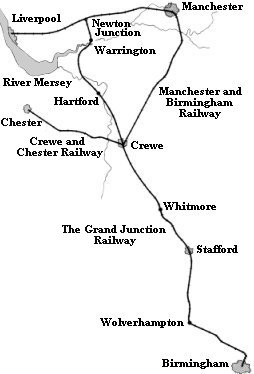 |
The Grand Junction Railway ran from Newton Junction on the
Liverpool and Manchester Railway to Birmingham. The map only
shows the first class stations. There were also 18 intermediate
stations. The Bill for the Grand Junction Railway, which was named after the Newton
Le Willows junction, was Passed in Parliament on May 6th 1833 on
the same day as the Passing of the Bill for the London & Birmingham Railway.
Work on the Grand Junction Railway began with the purchase of
the Warrington & Newton Railway for £73,400, after some hard
bargaining with its shareholders. Unfortunately its track needed
upgrading which cost a further £6,000, but even so the total
expense was less than the cost of building an alternative line.
The estimated cost of the remaining 78 miles was £20,000 a
mile. Little time was lost and construction soon got underway. |
Construction
Three engineers were employed to share the engineering duties. They were
George Stephenson, who was in overall control, Joseph Locke, who looked
after the construction of the northern half, and John Rastrick who looked
after
the construction of the southern half.
This was an interesting time for
Joseph
Locke as up until now he had worked for George Stephenson, and although
he had made quite a name for himself due to the excellent work that he did
in
the construction of the Liverpool & Manchester Railway, he was still seen as
Stephenson's pupil, and so the deserved praise was given to Stephenson. |
 |
| Locke was now his own man and was determined to prove himself in his own
right, and so he laboured vigorously in the construction of the line. Both
Stephenson and Rastrick however were involved in other projects and so their
commitment, and amount of time spent in the construction work was much less
than Joseph Locke. This caused problems between the engineers themselves
and the company directors, which led to Rastrick's resignation in September
1833, eventually followed by Stephenson's resignation on September 16th
1835. After Rastrick had left, Locke and Stephenson shared the engineering
duties with Locke concentrating on the northern part from Whitmore to
Warrington, and Stephenson on the southern part from Whitmore to
Birmingham. There was some bitterness between the two men as Stephenson
still considered Locke to be a junior, and not an equal, but Locke however,
revelled in his new task. |
|
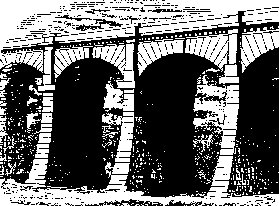
The
Dutton Viaduct. |
The principal engineering features were the Warrington
Viaduct crossing the River Mersey, and the Irwell & Mersey
Canal, immediately followed by a deep cutting, one a quarter
miles long. The Dutton Viaduct crossed the River Weaver, and
the Weaver Canal. It was 60 feet high and 500 yards long.
The next feature of interest, the Penkridge Viaduct, had 7 arches
and
foundations that were buried in concrete to a depth of 70 feet. |
| Immediately
after
Wolverhampton station, which was the highest point on the line, there was a
deep
300 yards long cutting, followed by Summit Tunnel which at 186 yards long
carried the railway under Wolverhampton Road and the Wyrley & Essington
Canal. The last 14 miles was quite troublesome as it produced many totally
unexpected problems, the first being a small aqueduct carrying the Bentley
Branch
of the Birmingham Canal across the Darlaston Green Cutting. A temporary
canal
was built as a diversion, while construction got underway. The aqueduct used a cast
iron
liner to contain the water, and when filled a severe leakage developed. The
canal had to be re-diverted so that the problem could be solved. It took a great
deal
of time and was the last part of the railway to be completed. |
| It was decided to divert the River Tame near Great Barr to
reduce the number of times that the railway had to cross the
river. The greatest and most difficult of all the earthworks was
the Newton Cutting, which had a depth of 80 feet in the centre.
In order to complete it on time the large workforce operated
around the clock. On the outskirts of Birmingham a detour was needed which required a
further
Act of Parliament. The resident of Aston Hall was James Watt who was the
son of the famous engineer, and was bitterly opposed to the line passing
through
his grounds. This late change to the route required the hasty design and
construction of several extra bridges, viaducts and embankments, which
greatly increased Locke's workload. |
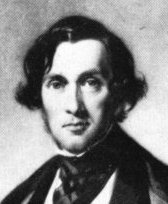
Joseph Locke. |
| The construction of the line in record time was
a
great triumph for Locke. The average cost was less than the estimated
£20,000
per mile, which was very cheap when compared with the cost of the London &
Birmingham Railway at £46,000 per mile. Running
Considering that this was the first long-distance line in the world, its
opening was a
very quiet affair. A train pulling 3 coaches and a mail coach set off from
Liverpool,
and a similar one set off from Manchester. They met at Newton Junction where
both trains were combined and hauled southwards to Birmingham by the
locomotive
Wildfire.
The venture was a great success. In the first six months of
operation it carried 232,202 passengers, and continued to
prosper during its nine-year life. |
|
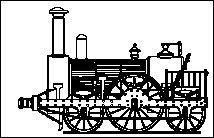
An engine constructed at the Haig Foundry and delivered on Sept 20th 1838. |
In October 1840 the Grand Junction Railway took over the Crewe & Chester
Railway to use as a basis for a route to Ireland via Holyhead.
Amalgamation
It continued as a separate railway until an Act of Parliament was passed on
July
16th 1846 which allowed the amalgamation of the Grand Junction Railway with
the London & Birmingham Railway and the Liverpool & Manchester Railway.
The new company was called the London & North Western Railway Company
and became the countries largest railway.
|
The amalgamation occurred because
of
pressure from joint shareholders who had doubts about their investment in
two
warring companies, and the individual companies themselves realised that
they
could not realistically expect to retain their monopoly of the Manchester /
Liverpool to London route in the face of the increasing number of new
railway
lines that were being proposed.This amalgamation must have surprised many
people at the time, because prior to this the two largest companies thoroughly
distrusted each other. The London & Birmingham Railway and Grand Junction
Railway violently quarrelled over the London & Birmingham's Trent Valley
scheme,
and the Grand Junction's interest in a route to Shrewsbury. Ayear prior to
the
amalgamation the London & Birmingham joined forces with the Manchester &
Birmingham Railway due to the latter's reliance on, and distrust of the
Grand
Junction. In the event, each of the constituent parts was far more
successful than it
had been before amalgamation, and the resulting company was one of the most
successful of the Victorian railway companies. |
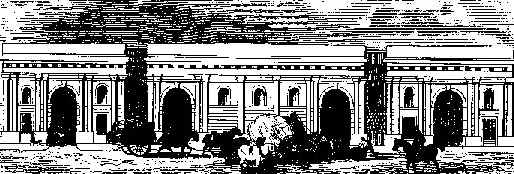
Curzon Street Terminus in Birmingham.
 |
Return to the
previous page |
|